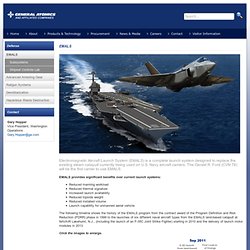

Airbus' Eco-Climb Concept. Launching Airplanes from Catapults, Part 3: Airbus' Eco-Climb Concept. While many eyes in the commercial airline industry were undoubtedly watching the U.S.

Navy's EMALS (Electromagnetic Aircraft Launch System) testing, it is Airbus that has first stepped forward suggesting commercial applications. Earlier this year the manufacturer announced "Smarter Skies," a series of concepts and promotional videos revealing where they want to be by 2050. One component in their plan is for an EMALS-like system, though they never directly refer to military subcontractor General Atomics' invention; instead the company calls it "Eco-Climb," writing that "Aircraft could be manoeuvred onto a track system and accelerated using either electro-magnetic motors built into the track or an inductive circuit within the aircraft itself. " Starting at 0:52 in the promo video below, you can see they're envisioning a much wider platform than what EMALS uses, this one scaled up to accommodate a commercial jetliner: Eco-climb The Future by Airbus - Airbus unveils its 2050 vision for "Smarter Skies"
Navy’s magnetic launch system a success. The U.S.

Navy’s new electro-magnetic aircraft launch system (EMALS) — perhaps the most critical unproven element in the first new aircraft carrier design in four decades — launched its first aircraft Dec. 18, manufacturer General Atomics has confirmed. The launch of an F/A-18E Super Hornet supersonic strike fighter took place at Naval Air System Command’s facility at the Naval Air Engineering Station Lakehurst, N. J., Navy officials confirmed. One launch was conducted on Dec. 18, while several more launches took place the following day. A lot is riding on the successful development of the new launch system. An official announcement by the Navy confirming the launches is expected to be released Dec. 20. More than 722 launches of test loads have been made at the Lakehurst facility this year, at speeds up to 180 knots, the highest end-speed requirement for the system.
Videos You May Be Interested In. Electromagnetic Aircraft Launch System. The Electromagnetic Aircraft Launch System (EMALS) is a system under development by the United States Navy to launch carrier-based aircraft from catapults using a linear motor drive instead of conventional steam pistons.

This technology reduces stress on airframes because they can be accelerated more gradually to takeoff speed than with steam-powered catapults. Other advantages includes lower system weight, cost, and maintenance; the ability to launch both heavier and lighter aircraft than conventional systems; and lower requirements for fresh water, reducing the need for energy-intensive desalination. Design and development[edit] The EMALS is being developed by General Atomics for the U.S. Navy's newest Gerald R. In June 2010, the land-based prototype of the system passed initial tests, with the first aircraft launch from the system taking place at the end of 2010.[1] Linear induction motor[edit] Energy storage subsystem[edit] Power conversion subsystem[edit] Control consoles[edit] Navy Tests Electromagnetic Aircraft Launch System (EMALS)
EMALS. Electromagnetic Aircraft Launch System (EMALS) is a complete launch system designed to replace the existing steam catapult currently being used on U.S.

Navy aircraft carriers. The Gerald R. Ford (CVN 78) will be the first carrier to use EMALS. EMALS provides significant benefits over current launch systems: Reduced manning workload Reduced thermal signature Increased launch availability Reduced topside weight Reduced installed volume Launch capability for unmanned aerial vehicle The following timeline shows the history of the EMALS program from the contract award of the Program Definition and Risk Reduction (PDRR) phase in 1999 to the launches of six different naval aircraft types from the EMALS land-based catapult at NAVAIR Lakehurst, N.J., (including the launch of an F-35C Joint Strike Fighter) starting in 2010 and the delivery of launch motor modules in 2013. Click the images to enlarge.